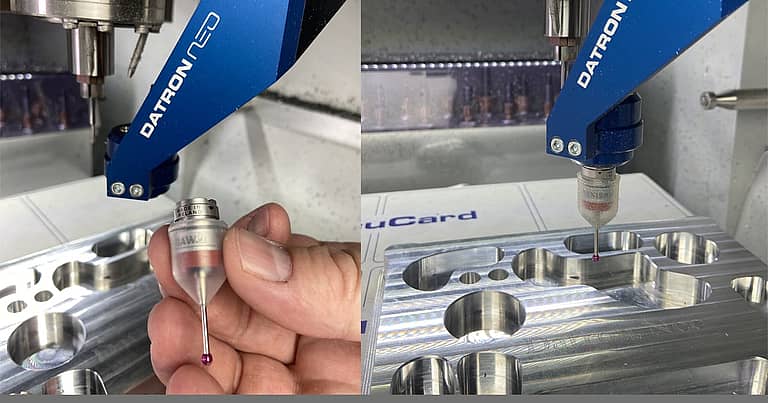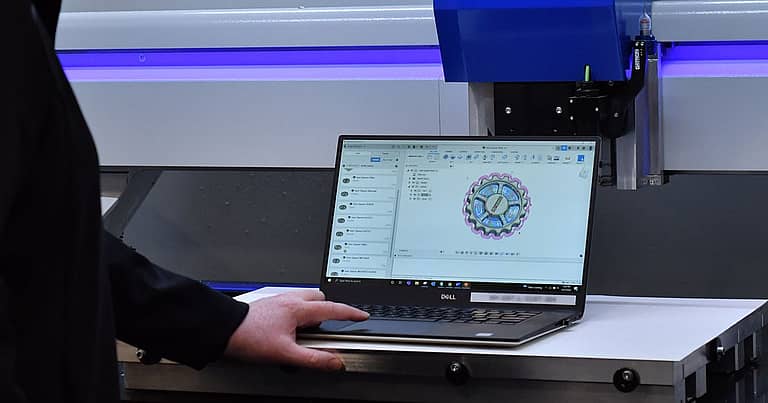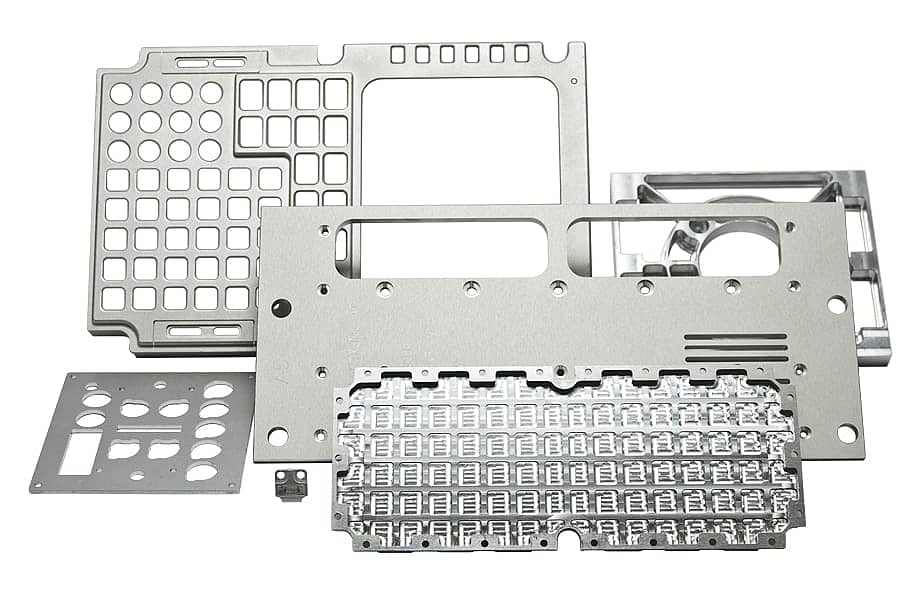
Optimizing CNC milling speed for aluminum materials is crucial for achieving efficient machining processes, maximizing productivity, and ensuring the quality of the finished parts. Aluminum is a widely used material in various industries due to its lightweight properties, excellent machinability, and corrosion resistance. However, machining aluminum presents unique challenges compared to other metals like steel or titanium.
When determining the optimal CNC milling speed for aluminum, several factors need to be considered such as the material grade and alloy, cutting tools, cutting speeds, feed rates, and more. All these factors can make stepping into the world of high speed milling aluminum a daunting task, but not to fear! Our experts have put together some tips and rates for milling that will help you tackle any aluminum milling project with ease.
Aluminum & Milling
First, let’s talk about the different kinds of aluminum alloys you may run into and what that means for milling speed. There are numerous alloys, each with their unique composition and properties. Some alloys exhibit greater hardness and thermal conductivity than others, affecting how they respond to milling. For instance, 6061 aluminum, a commonly used alloy, typically requires different milling parameters than softer variants like 1100 aluminum.
Next, you will need to consider the tool material you are using and the geometry of that tool when calculating the milling speed for aluminum. The choice of cutting tool plays a significant role in determining the speed, and here are a few reasons why:
Carbide end mills are preferred for aluminum due to their durability and heat resistance. The hardness of carbide end mills allows them to maintain their cutting-edge sharpness for a longer time, resulting in better performance and longer tool life. Carbide end mills also pack a punch when it comes to heat resistance. These tools can withstand high temperatures without losing their hardness, making them especially well-suited for high speed milling aluminum.
Additionally, factors such as flute geometry, coating, and tool diameter influence the cutting forces and heat generation, thereby impacting the ideal milling parameters. Our experts at DATRON recommend using a DATRON’s 4 in 1 single flute tools which are best for balancing chip evacuation and floor finishing when milling aluminum.
Once you understand the material and tools you are working with, you must balance the cutting speed, feed rate, and depth of cut to complete your project. To make this easier to understand, our experts have broken these topics down even further.
Cutting Speed
Cutting speed refers to the speed at which the cutting tool moves relative to the workpiece surface. For high speed milling aluminum, faster cutting speeds are generally preferred to maintain efficient material removal rates and prevent built-up edge formation. However, the machinist needs to keep in mind that excessive cutting speeds can lead to tool wear, heat generation, and poor surface finish. The recommended cutting speeds for aluminum typically range depending on the alloy and tooling. See the Aluminum Milling Speed Chart below for more information on cutting speeds.
Feed Rate
The feed rate determines how quickly the cutting tool advances into the workpiece. The feed rate affects chip formation, tool wear, and surface finish, all aspects to consider when selecting the milling speed for your project. A balance between cutting speed and feed rate is necessary to achieve optimal chip evacuation and prevent chip recutting. The feed rate for aluminum milling is typically higher than that for other materials to maintain chip thinning and prevent chip buildup.
Depth of Cut
The depth of cut refers to the distance the cutting tool penetrates the workpiece during each pass. In aluminum milling, shallow depths of cut are often preferred to minimize tool deflection, vibration, and heat generation. However, increasing the depth of cut can improve material removal rates in certain applications, provided that the cutting parameters are adjusted accordingly.
Now that we have established the foundations for milling aluminum, it is time to help you find the optimal milling rates!
Tips For Finding the Optimal Milling Speed for Aluminum
Achieving the ideal milling speed for aluminum requires a systematic approach, often involving adjustments and optimization. Here are some expert tips for determining the ideal cutting parameters to ensure you are machining at the most efficient and effective speeds for your aluminum project.
1. Start with Recommendations:
As always, begin by consulting machining handbooks, tool manufacturers’ recommendations, or online resources such as feed rate calculators for initial milling speed guidelines based on the specific aluminum alloy and tooling used. Doing your research in advance can save you time, money, and frustration in the long run.
2. Evaluate the Machining Process
Our machinist experts know that evaluating the machining process is a crucial part of any project, but this is especially true when determining the spindle speed for milling aluminum. Pay attention to the machine when running your part for early detection of any potential problems.
If you hear a humming sound, this could indicate that the spindle is moving too quickly, causing a vibration. Visually, you may see that the finish will start to look “chattery” or rough, not giving you the smooth finish expected. You can always pause the machining process to feel how smooth or rough the part is as the last step to knowing if the speed of the operation is too fast or too slow.
3. Consider Your Workholdings
Another crucial aspect to consider is the workholdings, which will impact the milling speed. It’s important to understand that parts machined in a vice will differ from what you machine on a vacuum table or pneumatic workholding. Each workholding may create different vibrations requiring you to adjust the milling speed for optimal results. For workholdings like vices and vacuum tables, the rigidity offered allows for more aggressive milling, or high speed milling, which is necessary for roughing operations.
It’s also important to consider the size and weight within the workholding as this is another variable that can affect how quickly you mill. When considering your workholding options, keep in mind that vice workholding allows for faster machine operations and is more repeatable when machining multiple of the same part.
4. Check Your Coolant
For beginners, you might not consider how coolant plays a crucial part in optimizing the milling speed, but our experts are here to tell you that it certainly does! As we discussed, high speed milling aluminum can create a lot of heat which can weld the chip in the tool without the proper cooling. Making sure your coolant reaches the tip of your tool will support smooth milling operations. Be sure to adjust your coolant for each application properly.
DATRON CNC machines offer an excellent coolant solution using ethanol instead of flood coolant to keep the workpiece cool and reduce friction. Having a cool and dry workpiece also gives you the optimal conditions for high speed milling. Not to mention that these conditions are also excellent for better chip excavation.
5. Machine Rigidity and Stability
The rigidity and stability of the CNC machine play a significant role in achieving optimal milling speeds for aluminum. Machines with robust structures and high-quality components can withstand the forces generated during high-speed machining while maintaining dimensional accuracy. It’s important to remember that not all CNC machines are the same. A hobbyist machine will most likely not be as rigid and stable as a high-quality CNC machine. 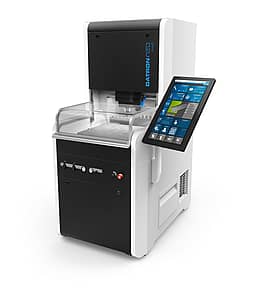
It may also seem like a no-brainer, but having a stable and level machine will impact the speed rates, as well as the quality of the finished project. Know the structure and stability of your machine before you start to mill, and check to ensure that it is level.
6. Optimize for Efficiency and Adjust
Once the optimal speed range is identified, fine-tune the parameters to maximize efficiency while maintaining tool life and workpiece quality. This may involve adjusting the feed rate, depth of cut, or tool path strategy. Keep a close eye on your workpiece and know when to pause the machine operation to make the appropriate adjustments. Over time, you will know what speeds work best for your workpiece specifications.
Remember, machining conditions can change over time due to factors like tool wear or material variations. Therefore, it’s essential to continuously monitor the process and adjust as needed to ensure consistent performance. Before you know it, you will be milling like a pro!
Aluminum Material Table
This is a general overview of common aluminum alloys and their mechanical properties. This chart serves as a resource for understanding the diverse characteristics of various aluminum alloys frequently utilized across industries. From the lightweight and corrosion-resistant 6061 alloy to the high-strength 7075 alloy, this chart delineates essential mechanical properties such as tensile strength, yield strength, elongation, and more. Whether assessing for structural integrity, machinability, or thermal conductivity, this chart offers a succinct yet informative portrayal of aluminum alloys, facilitating informed decision-making and enhancing the efficiency of design and production processes.
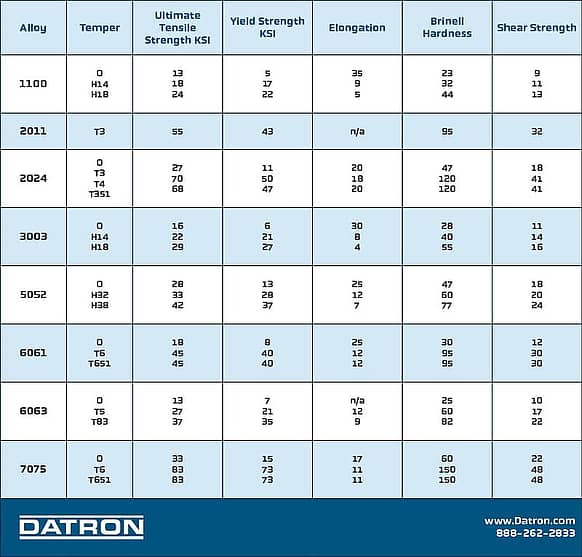
Aluminum Milling Speed Chart
It is important to note that this chart is specifically crafted for milling on the DATRON neo using a Single Flute End Mill. Speeds will likely need to be adjusted for other CNC machines and tool types.
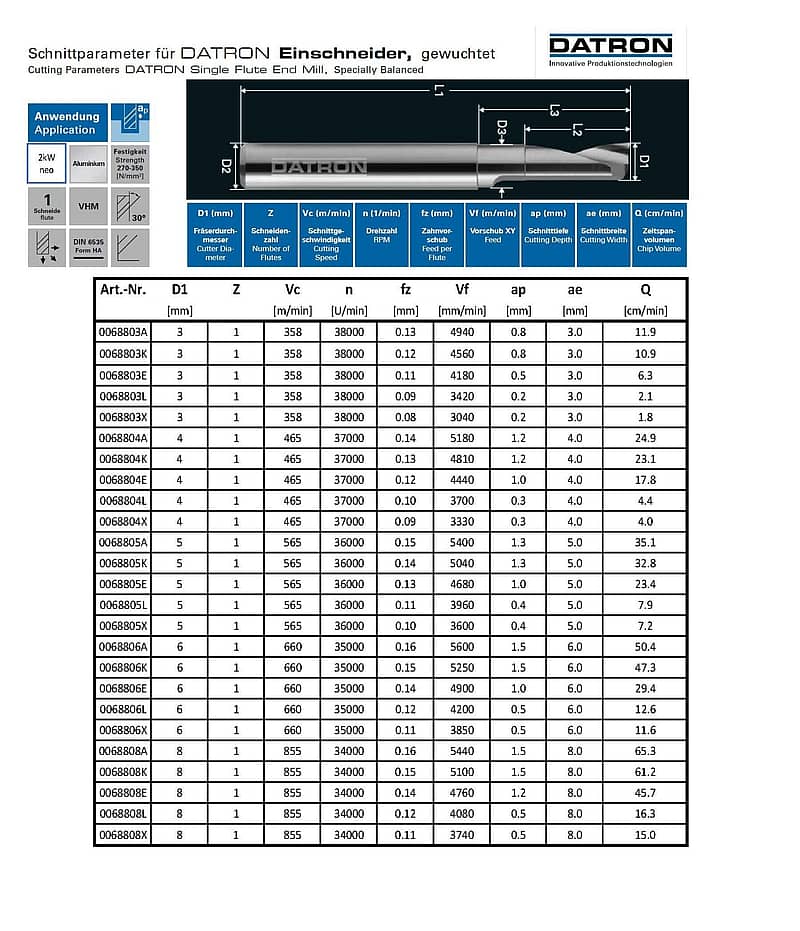
Conclusion
As you can see, optimizing CNC milling speed for aluminum materials requires a thorough understanding of aluminum properties, cutting tool selection, and machining parameters. You can achieve efficient machining processes by carefully adjusting cutting speeds, feed rates, depths of cut, and coolant/lubrication strategies. Following our expert tips, referencing aluminum milling speed charts and continuously monitoring the machine is essential for any high speed milling aluminum projects.
Our experts at DATRON know the potential challenges that come with milling aluminum. They also know that using DATRON CNC machines can significantly reduce the learning curve due to the user-friendly nature and design of our machines. Contact us today to see how simple CNC machining can be and how easily you can become a pro with any material. We guarantee that you will be requesting a quote to see how you can start milling on a DATRON CNC machine today!





